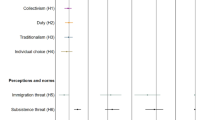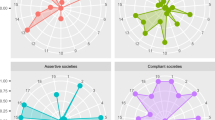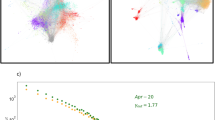Abstract
Culture plays a pivotal role in shaping collective level processes, with implications for public opinion on issues such as COVID-19 vaccination. Drawing on Hofstede's cultural dimension theory, we theoretically examine the influence of two key dimensions of culture, individualism/collectivism and power distance, on the opinion formation of individuals within a dynamic and evolving context. While former models suggest that collectivism promotes opinion consensus, our findings reveal a more complex relationship, particularly in scenarios where centralization or decentralization of a society is considered. By conducting multiple simulation experiments through an agent-based model, we find that collectivism can contribute to opinion consensus in a simple scenario in which only social norms work without any impact from authorities. However, a collectivist society also has the potential to experience high opinion polarization in the presence of greater decentralization among authorities, particularly in settings of high power distance. Simulation results further demonstrate that disagreement between authorities is more likely to result in opinion polarization in individualist cultures compared to collectivist cultures.
















Similar content being viewed by others
Data availability
The datasets generated and analyzed during the current study can be replicated by running the model implemented with NetLogo 6.0.4, which is openly available on the CoMSES Computational Model Library at: https://www.comses.net/codebase-release/800a4c2e-7a27-47d5-b06e-ddf81bf89cb7/.
Notes
Strictly speaking the mRNA technology is not a vaccine, but for readability we will use this widely used terminology.
References
Flache, A., Mäs, M., Feliciani, T., Chattoe-Brown, E., Deffuant, G., Huet, S., & Lorenz, J. (2017). Models of social influence: Towards the next frontiers. Journal of Artificial Societies and Social Simulation, 20(4), 2. https://doi.org/10.18564/jasss.3521
Huet, S., & Deffuant, G. (2010). Openness leads to opinion stability and narrowness to volatility. Advances in Complex Systems, 13(03), 405–423. https://doi.org/10.1142/S0219525910002633
Jager, W., & Amblard, F. (2005). Uniformity, bipolarization and pluriformity captured as generic stylized behavior with an agent-based simulation model of attitude change. Computational & Mathematical Organization Theory, 10(4), 295–303. https://doi.org/10.1007/s10588-005-6282-2
Hegselmann, R., & Krause, U. (2002). Opinion dynamics and bounded confidence: models, analysis and simulation. Journal of Artificial Societies and Social Simulation, 5(3), 1–33.
Keijzer, M. A., Mäs, M., & Flache, A. (2018). Communication in online social networks fosters cultural isolation. Complexity, 2018, e9502872. https://doi.org/10.1155/2018/9502872
Quattrociocchi, W., Caldarelli, G., & Scala, A. (2014). Opinion dynamics on interacting networks: Media competition and social influence. Scientific Reports, 4(1), 4938. https://doi.org/10.1038/srep04938
Takesue, H. (2020, November 27). A noisy opinion formation model with two opposing mass media. arXiv. https://doi.org/10.48550/arXiv.2011.13813
Ulloa, R., Kacperski, C., & Sancho, F. (2016). Institutions and cultural diversity: Effects of democratic and propaganda processes on local convergence and global diversity. PLoS ONE, 11(4), e0153334. https://doi.org/10.1371/journal.pone.0153334
Li, K., Liang, H., Kou, G., & Dong, Y. (2020). Opinion dynamics model based on the cognitive dissonance: An agent-based simulation. Information Fusion, 56, 1–14. https://doi.org/10.1016/j.inffus.2019.09.006
Martins, A. C. R. (2008). Continuous opinions and discrete actions in opinion dynamics problems. International Journal of Modern Physics C, 19(04), 617–624.
Sun, R., & Mendez, D. (2017). An application of the continuous opinions and discrete actions (CODA) model to adolescent smoking initiation. PLoS ONE, 12(10), e0186163.
Roozmand, O., Ghasem-Aghaee, N., Hofstede, G. J., Nematbakhsh, M. A., Baraani, A., & Verwaart, T. (2011). Agent-based modeling of consumer decision making process based on power distance and personality. Knowledge-Based Systems, 24(7), 1075–1095. https://doi.org/10.1016/j.knosys.2011.05.001
Vanhée, L., & Dignum, F. (2018). Explaining the emerging influence of culture, from individual influences to collective phenomena. Journal of Artificial Societies and Social Simulation, 21(4), 11.
Kreulen, K., de Bruin, B., Ghorbani, A., Mellema, R., Kammler, C., Vanhée, L., & Dignum, F. (2022). How culture influences the management of a pandemic: A simulation of the COVID-19 crisis. Journal of Artificial Societies and Social Simulation, 25(3), 6.
Haidt, J., & Graham, J. (2007). When morality opposes justice: Conservatives have moral intuitions that liberals may not recognize. Social Justice Research, 20(1), 98–116. https://doi.org/10.1007/s11211-007-0034-z
Tyler, T. R. (1997). The psychology of legitimacy: A relational perspective on voluntary deference to authorities. Personality and Social Psychology Review, 1(4), 323–345. https://doi.org/10.1207/s15327957pspr0104_4
Bernacer, J., García-Manglano, J., Camina, E., & Güell, F. (2021). Polarization of beliefs as a consequence of the COVID-19 pandemic: The case of Spain. PLoS ONE, 16(7), e0254511. https://doi.org/10.1371/journal.pone.0254511
Lazarus, J. V., Wyka, K., White, T. M., Picchio, C. A., Gostin, L. O., Larson, H. J., & El-Mohandes, A. (2023). A survey of COVID-19 vaccine acceptance across 23 countries in 2022. Nature Medicine, 29(2), 366–375. https://doi.org/10.1038/s41591-022-02185-4
Leonhardt, J., & Pezzuti, T. (2022). Vaccination acceptance across cultures: The roles of collectivism, empathy, and homophily. Journal of International Marketing, 30(2), 13–27.
Hofstede, G., Gert Jan Hofstede, & Michael Minkov. (2010). Cultures and Organizations: Software of the Mind, Third Edition (Vol. Revised and expanded third edition). New York: McGraw Hill. Retrieved from http://search.ebscohost.com.proxy-ub.rug.nl/login.aspx?direct=true&db=nlebk&AN=351480&site=ehost-live&scope=site
Hofstede, G. J., Jonker, C. M., & Verwaart, T. (2012). Cultural differentiation of negotiating agents. Group Decision and Negotiation, 21(1), 79–98. https://doi.org/10.1007/s10726-010-9190-x
Lu, J. G., Jin, P., & English, A. S. (2021). Collectivism predicts mask use during COVID-19. Proceedings of the National Academy of Sciences, 118(23), e2021793118. https://doi.org/10.1073/pnas.2021793118
Shavitt, S., & Barnes, A. J. (2020). Culture and the Consumer Journey. Journal of Retailing, 96(1), 40–54. https://doi.org/10.1016/j.jretai.2019.11.009
Triandis, H. C. (2018). Individualism And Collectivism. Routledge.
Betsch, C., Böhm, R., Korn, L., & Holtmann, C. (2017). On the benefits of explaining herd immunity in vaccine advocacy. Nature Human Behaviour, 1(3), 1–6. https://doi.org/10.1038/s41562-017-0056
Luo, C., Chen, A., Cui, B., & Liao, W. (2021). Exploring public perceptions of the COVID-19 vaccine online from a cultural perspective: Semantic network analysis of two social media platforms in the United States and China. Telematics and Informatics, 65, 101712. https://doi.org/10.1016/j.tele.2021.101712
Li, T., & Jager, W. (2023). How availability heuristic, confirmation bias and fear may drive societal polarisation: An opinion dynamics simulation of the case of COVID-19 vaccination. Journal of Artificial Societies and Social Simulation, 26(4), 2.
Ibanez, A., & Sisodia, G. S. (2022). The role of culture on 2020 SARS-CoV-2 country deaths: A pandemic management based on cultural dimensions. GeoJournal, 87(2), 1175–1191. https://doi.org/10.1007/s10708-020-10306-0
Gonzalez, K. E., James, R., Bjorklund, E. T., & Hill, T. D. (2021). Conservatism and infrequent mask usage: A study of US counties during the novel coronavirus (COVID-19) pandemic. Social Science Quarterly, 102(5), 2368–2382. https://doi.org/10.1111/ssqu.13025
Hornsey, M. J., Finlayson, M., Chatwood, G., & Begeny, C. T. (2020). Donald Trump and vaccination: The effect of political identity, conspiracist ideation and presidential tweets on vaccine hesitancy. Journal of Experimental Social Psychology, 88, 103947. https://doi.org/10.1016/j.jesp.2019.103947
Ruiz, J. B., & Bell, R. A. (2021). Predictors of intention to vaccinate against COVID-19: Results of a nationwide survey. Vaccine, 39(7), 1080–1086. https://doi.org/10.1016/j.vaccine.2021.01.010
Gilbert, N., & Troitzsch, K. (2005). Simulation For The Social Scientist. McGraw-Hill Education.
Flache, A., & Macy, M. (2011). Small worlds and cultural polarization. The Journal of Mathematical Sociology, 35(1–3), 146–176. https://doi.org/10.1080/0022250X.2010.532261
Cialdini, R. B., & Trost, M. R. (1998). Social influence: Social norms, conformity and compliance. McGraw-Hill Education.
Hofstede, G. (2001). Culture’s Consequences: Comparing Values, Behaviors, Institutions and Organizations Across Nations. SAGE.
Suh, E., Diener, E., Oishi, S., & Triandis, H. C. (1998). The shifting basis of life satisfaction judgments across cultures: Emotions versus norms. Journal of Personality and Social Psychology, 74(2), 482–493. https://doi.org/10.1037/0022-3514.74.2.482
Cremonini, M., & Maghool, S. (2020, October 31). The Unknown of the Pandemic: An Agent-based Model of Final Phase Risks. SSRN Scholarly Paper, Rochester, NY. https://doi.org/10.2139/ssrn.3584368
Heinke, D., Carslaw, G., & Christian, J. (2013). An agent-based simulation of destigmatization (DSIM): Introducing a contact theory and self-fulfilling prophecy approach. Journal of Artificial Societies and Social Simulation, 16(4), 10.
Suo, S., & Chen, Y. (2008). The dynamics of public opinion in complex networks. Journal of Artificial Societies and Social Simulation, 11(4), 2.
Quattrociocchi, W., Conte, R., & Lodi, E. (2011). Simulating Opinion Dynamics in Heterogeneous Communication. arXiv. https://doi.org/10.48550/arXiv.1101.3085
Moldovan, S., Muller, E., Richter, Y., & Yom-Tov, E. (2017). Opinion leadership in small groups. International Journal of Research in Marketing, 34(2), 536–552. https://doi.org/10.1016/j.ijresmar.2016.11.004
van Eck, P. S., Jager, W., & Leeflang, P. S. H. (2011). Opinion leaders’ role in innovation diffusion: A simulation study. Journal of Product Innovation Management, 28(2), 187–203. https://doi.org/10.1111/j.1540-5885.2011.00791.x
Manzo, G., & van de Rijt, A. (2020). Halting SARS-CoV-2 by Targeting High-Contact Individuals. Journal of Artificial Societies and Social Simulation, 23(4), 10. https://doi.org/10.18564/jasss.4435
Katz, E. (1957). The two-step flow of communication: An up-to-date report on an hypothesis*. Public Opinion Quarterly, 21(1), 61–78. https://doi.org/10.1086/266687
Hage, J., & Aiken, M. (1967). Relationship of centralization to other structural properties. Administrative Science Quarterly, 12(1), 72–92. https://doi.org/10.2307/2391213
Godfray, H. C. J., Beddington, J. R., Crute, I. R., Haddad, L., Lawrence, D., Muir, J. F., & Toulmin, C. (2010). Food security: The challenge of feeding 9 billion people. Science, 327(5967), 812–818. https://doi.org/10.1126/science.1185383
Angelini, P., Cerulli, G., Cecconi, F., Miceli, M.-A., & Potì, B. (2017). R&D Subsidization effect and network centralization: Evidence from an agent-based micro-policy simulation. Journal of Artificial Societies and Social Simulation, 20(4), 4.
Dahlberg, Kenneth. A. (2008). Pursuing Long-Term Food and Agricultural Security in the United States: Decentralization, Diversification, and Reduction of Resource Intensity. In Food and the Mid-level Farm: Renewing an Agriculture of the Middle (Vol. 23).
Wilensky, U. (1999). NetLogo. http://ccl.northwestern.edu/netlogo/. Retrieved from https://cir.nii.ac.jp/crid/1573387449823174784
Duggins, P. (2017). A psychologically-motivated model of opinion change with applications to american politics. Journal of Artificial Societies and Social Simulation, 20(1), 13. https://doi.org/10.18564/jasss.3316
Hegselmann, R., & Krause, U. (2015). Opinion dynamics under the influence of radical groups, charismatic leaders, and other constant signals: A simple unifying model. Networks and Heterogeneous Media, 10, 477–509. https://doi.org/10.3934/nhm.2015.10.477
Keijzer, M. A., & Mäs, M. (2021). The strength of weak bots. Online Social Networks and Media, 21, 100106. https://doi.org/10.1016/j.osnem.2020.100106
Flache, A. (2018). About renegades and outgroup haters: modeling the link between social influence and intergroup attitudes. Advances in Complex Systems, 21(06n07), 1850017. https://doi.org/10.1142/S0219525918500170
Baccini, E., Christoff, Z., Hartmann, S., & Verbrugge, R. (2023). The wisdom of the small crowd: Myside bias and group discussion. Journal of Artificial Societies and Social Simulation, 26(4), 7.
Mollenhorst, G., Völker, B., & Flap, H. (2008). Social contexts and core discussion networks: Using a choice approach to study similarity in intimate relationships. Social Forces, 86(3), 937–965. https://doi.org/10.1353/sof.0.0010
Gestefeld, M., Lorenz, J., Henschel, N. T., & Boehnke, K. (2022). Decomposing attitude distributions to characterize attitude polarization in Europe. SN Social Sciences, 2(7), 110. https://doi.org/10.1007/s43545-022-00342-7
Bramson, A., Grim, P., Singer, D. J., Fisher, S., Berger, W., Sack, G., & Flocken, C. (2016). Disambiguation of social polarization concepts and measures. The Journal of Mathematical Sociology, 40(2), 80–111. https://doi.org/10.1080/0022250X.2016.1147443
Esteban, J.-M., & Ray, D. (1994). On the measurement of polarization. Econometrica, 62(4), 819–851. https://doi.org/10.2307/2951734
Hofstede, G. (n.d.). Hofstede’s cultural dimensions (with world maps of dimensional values). Retrieved from https://clearlycultural.com/geert-hofstede-cultural-dimensions/
Cai, Y. (2008). Power structure and regime resilience: Contentious politics in China. British Journal of Political Science, 38(3), 411–432. https://doi.org/10.1017/S0007123408000215
Lu, J. G. (2023). Two large-scale global studies on COVID-19 vaccine hesitancy over time: Culture, uncertainty avoidance, and vaccine side-effect concerns. Journal of Personality and Social Psychology, 124, 683–706. https://doi.org/10.1037/pspa0000320
Acknowledgements
The authors are grateful to the ICS members and Shaoni Wang from University College Groningen for their helpful feedback. The second author acknowledges financial support by the Netherlands Organization for Scientific Research (NWO) under the 2018 ORA grant ToRealSim (464.18.112).
Author information
Authors and Affiliations
Contributions
TL: Conceptualization, Writing—original draft, Investigation, Methodology, Software, Visualization. AF: Conceptualization, Writing – review & editing, Investigation, Methodology, Supervision. WJ: Writing – review & editing, Conceptualization, Investigation, Supervision.
Corresponding author
Ethics declarations
Conflict of interest
The authors have no competing interests to declare that are relevant to the content of this article.
Additional information
Publisher's Note
Springer Nature remains neutral with regard to jurisdictional claims in published maps and institutional affiliations.
Appendices
Appendix 1: Establish social networks
The algorithm pseudocode to establish social networks between individuals and networks between authorities and individuals is presented below. The primary principle is that individuals form connections with geographically closest friends or authorities, with the model parameter Nf controlling the network's density.

Appendix 2: Long-term experiments
We present here supplementary experiments to illustrate whether different polarization outcomes are produced if the model is run for longer periods of time. This supplementary experiment is mainly an extension of Experiment 3 in the main text, considering the involvement of authority. The model run time has been extended to 1000 time steps, given the limitations of the model's running capacity, and the comparative analysis is sufficient to help predict the trend of the results.
Figure
17 depicts the evolution of opinion polarization for three levels of authority reach under different numbers of authorities, which is an extension of Fig. 8. The main difference between the results and those of Fig. 8 is that the polarization eventually shows a decreasing trend after the extension of the time step, and the larger the authority reach the faster the decrease. Earlier analysis has indicated that this is due to the fact that individual opinions eventually shift towards authority opinion. When the authority reach is at its maximum of 100%, this shift towards equilibrium results is achieved first. It is expected that situations with smaller authority reach will also achieve similar outcomes given enough time. However, it is important to note that the fundamental conclusion of Fig. 8 remains unchanged even with the extension of time steps, i.e., the maximum level of polarization is achieved when authority reach is 40%.
Figure
18 is an extension of Fig. 10, which examines the long-term effect of authority disagreement on opinion polarization. Despite the increased time step, the results are not significantly different. Similarly, Fig.
19 extends the time step from Fig. 12, but the simulation results do not show a significant difference.
Appendix 3: Different initial opinion distributions
This supplementary experiment explores the effect of different initial opinion distributions on polarization. Taking the case of Na = 2 in Fig. 8 as an example, we analyze the outcomes of four initial distributions, namely the random distribution (achieved by Beta (1, 1)), the unimodal distribution with most values distributed around 0 (Beta (1, 10)) and distributed around 0.5 (Beta (10, 10)), and the bimodal distribution (formed by the combination of Beta (10, 2) and Beta (2, 10)). Figure
20 displays the polarization evolutions. The highest degree of polarization remains largely unchanged under the condition of 40% authority reach.
The results of the extended experiment for Fig. 10 are shown in Fig.
21, and those for Fig. 12 are shown in Fig.
22. Although the evolution curves for polarization differ, the overall conclusions have not been reversed.
Appendix 4: Further explanation of the effects of decentralization of authorities with the same opinion
In Fig. 8 of the main paper, we showed that when the authorities share the same opinion and the total number of connections remains constant, changing only the number of authorities (i.e., varying degrees of decentralization) results in differences in the level of polarization within the population. In the main text we have elaborated an explanation for this possibly counterintuitive result. In short, we attribute this outcome to the influence between individuals. In this appendix we report an additional simulation experiment designed to test this explanation. In this experiment, we set the network degree to zero for all individuals (for all i: Nif = 0) meaning there is no interaction between individuals, using an example where the authority reach is 40% (as shown in Fig.
23). All other parameters are the same as in Experiment 3 (Fig. 8). If the interactions between individuals are responsible for the observed reduction in polarization with three authorities compared to one or two, this difference should disappear in this new experiment. Figure
24 confirms this hypothesis.
Rights and permissions
Springer Nature or its licensor (e.g. a society or other partner) holds exclusive rights to this article under a publishing agreement with the author(s) or other rightsholder(s); author self-archiving of the accepted manuscript version of this article is solely governed by the terms of such publishing agreement and applicable law.
About this article
Cite this article
Li, T., Flache, A. & Jager, W. How culture can affect opinion dynamics: the case of vaccination. J Comput Soc Sc 8, 18 (2025). https://doi.org/10.1007/s42001-024-00347-7
Received:
Accepted:
Published:
DOI: https://doi.org/10.1007/s42001-024-00347-7












